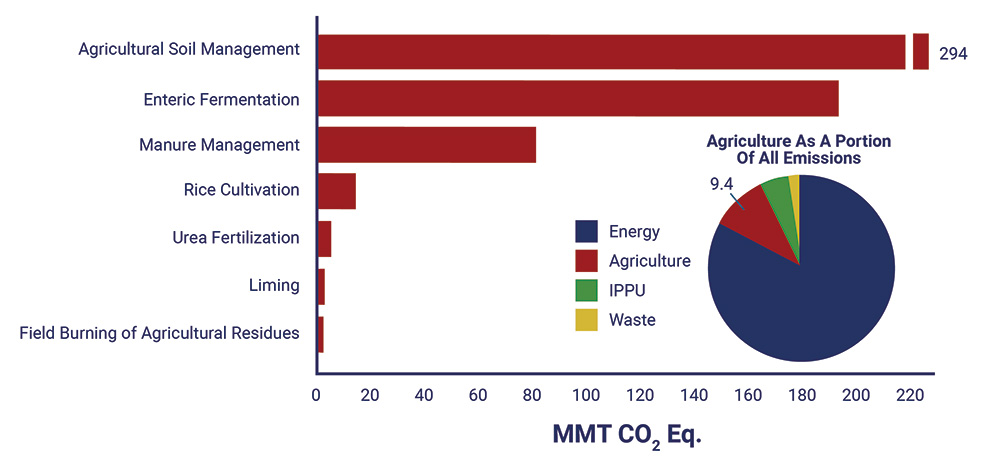The U.S. has historically been a global leader in agricultural innovation, resulting in the highly efficient production of agricultural products used for feed, fiber and fuel around the world. This U.S. agricultural innovation has doubled agricultural output while also using fewer inputs like water and labor, potentially reducing costs. Although U.S. agricultural production has a high success rate, it is still responsible for 9.4% of total U.S. emissions, while globally, agricultural emissions make up 21% of total emissions. To meet global emissions reduction goals, public and private sector stakeholders are prioritizing the development and deployment of agricultural solutions that increase domestic capabilities while reducing on-farm emissions of nitrous oxide, carbon dioxide and methane. Adoption of emissions-reducing, voluntary on-farm solutions will depend on scalability to various geographic regions, equal or improved productivity when implemented, producer buy-in, and international market signals.
Nitrous oxide is the largest agricultural sector greenhouse gas emissions, accounting for 49.2% of agriculture emissions. Promising innovations that reduce the amount of nitrous oxide released include the use of enhanced efficiency fertilizers, which can control fertilizer release or inhibit nutrient loss, and microbial fertilizers that support plant growth and nutrient uptake. Other emissions, such as methane, account for 46.5% of agricultural sector emissions, mainly from ruminants (cattle, sheep, goats, etc.) and manure management. Innovations to reduce these emissions include the use of anaerobic digesters, which address emissions from manure management and create valuable products like biogas or renewable natural gas (RNG), livestock breeding or engineering and feed additives to reduce enteric methane emissions from ruminants. Carbon dioxide emissions contributed 1.4% of agricultural emissions. Agricultural lands and crops can also be utilized for carbon sequestration through methods such as enhanced root crops and the use of biochar, a powdery-black stable carbon material spread on agricultural lands to absorb emissions and improve crop productivity.

Research and Development (R&D) Maintaining U.S. global leadership in agricultural innovation through R&D is important now more than ever, as major competitors like China and Brazil have begun outpacing the U.S. in federal agriculture R&D investments. For the U.S. to maintain leadership, it is important for resources to focus on the R&D of breakthrough solutions, deployment of new technologies and practices, and the voluntary adoption of science, technology, and innovation. R&D programs to support cutting-edge solutions could include the U.S. Department of Agriculture’s (USDA) version of the Department of Energy’s (DOE) Advanced Research Programs Agency-Energy (ARPA-E), the Agriculture Advanced Research and Development Authority (AgARDA), and efforts that support private sector solutions, such as the Foundation for Food and Agriculture Research (FFAR).
Wide-Scale Deployment and Voluntary Adoption Voluntary and incentive-based adoption of agricultural innovations are necessary for achieving wide-scale deployment of technologies and agriculture sector emissions reductions. Therefore, incentivizing U.S. producers’ adoption of cutting-edge technologies and practices could be achieved by leveraging existing conservation programs. For instance, with nitrous oxide being the largest agricultural emissions, the incorporation of nitrous oxide emissions reduction priorities to conservation programs like the USDA Natural Resources and Conservation Service (NRCS) Conservation Innovation Grants (CIG) On-Farm Conservation Innovation Trials could support the voluntary deployment of nitrous oxide reduction innovations.
Coordination Across Federal Agencies Optimized and cost-effective agricultural innovation research, development and deployment (R&D) is achievable through enhancing the coordination and collaboration among existing and future agriculture innovation research at relevant federal agencies, such as between the USDA, DOE, and the National Science Foundation (NSF). Coordinating efforts would streamline the innovation pipeline from research to deployment by sharing knowledge and expertise, while addressing redundancies in resource allocation. The establishment of a Biochar Research Network could improve the coordination and collaboration between federal agencies around biochar R&D across the U.S.
